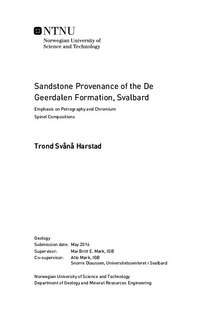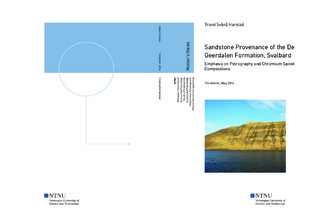| dc.description.abstract | Detrital chromium spinel mineral-chemical analyses, in combination with sandstone petrography, were conducted on samples from the Upper Triassic De Geerdalen Formation from several locations on Svalbard, in order to interpret sandstone provenance. Petrographic identification of detrital minerals and lithic fragments was used to identify source rock lithology. The accessory mineral chromium spinel was used as a petrogenetic marker to distinguish tectonic setting of mafic and ultra- mafic source rocks to the De Geerdalen Formation.
All detrital chromium spinels have a Fe3+ content above 25% and an Al content below 30%, when comparing the trivalent cations Cr, Fe3+ and Al. Comparing the divalent cations Mg and Fe2+, the Mg content is between 38 and 94%. Apatite, chromium spinel, garnet, rutile, tourmaline and zircon heavy minerals are observed in sandstones along with various lithic fragments of volcanic and metapelitic origin. A considerable polycrystalline quartz content represents deformed quartzite grains, chert and spiculites.
Comparing the observed chromium spinel compositional range to that in the literature indicates a compositional match with mafic to ultra- mafic continental intrusions, covering flood basalts, sub- volcanic intrusions and layered intrusions. The observed volcanic lithic fragments in the De Geerdalen Formation may have a similar origin as the detrital chromium spinels. On the other hand, the lithic clasts and heavy minerals indicate varying source rock lithologies of metasedimentary, sedimentary, volcanic and felsitic intrusive origin.
The closest known possible source to chromium spinel of continental intrusion composition, and likely source to De Geerdalen Formation chromium spinel, is located on the Taimyr peninsula, representing the northernmost part of the Siberian Traps Large Igneous Province. This provenance interpretation is supported by the existence of Siberian Traps related zircon age peaks in detrital zircons of the De Geerdalen Formation. No observations suggesting varying provenance between the different Svalbard locations and samples are made. | |

